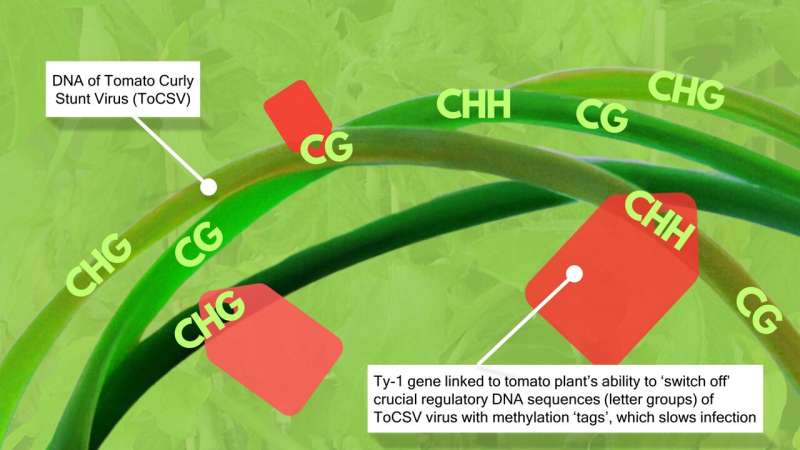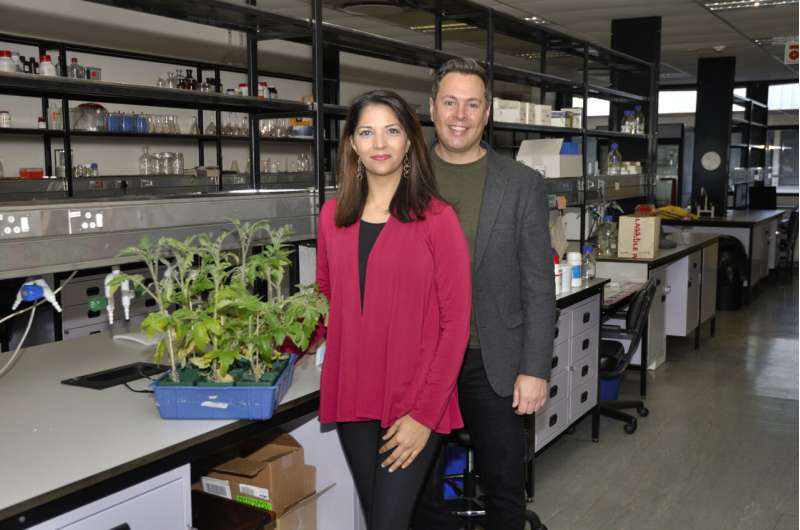This article has been reviewed according to Science X's editorial process and policies. Editors have highlighted the following attributes while ensuring the content's credibility:
fact-checked
peer-reviewed publication
proofread
Research explores first defense against devastating ToCSV tomato virus at a molecular genetics level

How tomato plants defend themselves against a devastating 'young' Southern African virus has now been investigated at a molecular genetics level for the first time by researchers at the University of Johannesburg (UJ).
The Ty-1 gene is known to confer resistance to the well-known tomato yellow leaf curl virus (TYLCV). UJ researchers investigated what happens when tomato plants that harbor the Ty-1 gene are infected with the relatively unknown tomato curly stunt virus (ToCSV). They found a link between tolerance to ToCSV, a plant defense called viral DNA methylation, and Ty-1 gene activity. The research is published in Frontiers in Plant Science.
To find out more about how that happens, they used lab techniques called bisulfite conversion and PCR amplification, coupled with a next-generation whole genome virus sequencing approach.
Young virus traveling
Many pathogens attack tomato plants, which produce the third biggest vegetable crop in the world, after potatoes and cassava.
Tomato curly stunt virus originated in South Africa about 30 years ago and is spread by whitefly. The virus can destroy an entire tomato crop, especially if enough plants are infected at a young stage. It has been found in neighboring country Mozambique also.
The young tomato curly stunt virus (ToCSV) is similar to the established tomato yellow leaf curl virus (TYLCV) at the DNA level.
But relatively little is known about any 'tools' the tomato plants can use to defend themselves against ToCSV, says Dr. Farhahna Allie, lead author on the study. Dr. Allie is a researcher in the UJ Department of Biochemistry.
Trojan horse trick inside plants
Viruses have been attacking plants since the dawn of time. But they still have to trick the plants, to replicate themselves and cause disease, says Dr. Gerrit Koorsen, co-author on the study.
"Geminiviruses like ToCSV do not have the capacity to make copies of themselves, and then to spread elsewhere. They are completely reliant on the plant for that. The virus has to trick the plant into 'thinking' that the plant is making more of its own DNA.
"So the virus is like a Trojan Horse inside the plant. The plant is replicating viral DNA 'without knowing it, 'taking care of the infection' and spreading the disease caused by the virus," he says.
Attacking DNA inside the virus
In the ongoing battle between plants and viruses, plants 'have discovered' that it is very effective to focus their counter-attack on the DNA inside viruses.
For the study, the researchers used a variety of tomato that is susceptible to ToCSV, and another variety that can tolerate it.
The susceptible variety has a number of defenses in its toolbox against other pathogens, but it cannot overcome ToCSV, says Allie. ToCSV can fully infect this variety.
Studying the way in which plants respond to a new virus like ToCSV is crucial to identifying ways of breeding resistant crops.
Resistance gene Ty-1
"The tolerant tomato variety has a similar genetic background to the susceptible variety, but it is better at switching on the Ty-1 resistance gene, which the susceptible variety struggles to do," says Allie.
"The Ty-1 gene is known to be the major resistance gene in tomatoes against tomato yellow leaf curl virus (TYLCV). The 'young' virus ToCSV is similar to the TYLCV in terms of its genome, and Ty-1 may therefore well be responsible for tolerance or resistance against ToCSV too.
"As a first step to explore the link between resistance and tolerance and the Ty-1 gene, we wanted to see whether the tolerant plant uses the DNA methylation 'tool' to combat tomato curly stunt disease," she says.
Switching off viral DNA
"Imagine the DNA of one tomato curly stunt virus as a tiny rubber band," says Koorsen. "When the whitefly feeds on the plant, the fly transfers thousands of these DNA rubber bands into the cells of the plant.
"Let's compare a cell of a plant that is susceptible to ToCSV, with a cell of a tomato plant that can tolerate ToCSV to some extent. In the tolerant plant cell the Ty-1 gene is very active.
"Given the data we analyzed in this study, we think Ty-1 activity may be linked to the ability of plants to tag specific areas on the viral DNA 'rubber band,' and 'switch them off,' so the virus cannot make more if itself inside the plant cell," says Koorsen.
The 'tags' are methyl groups. Each methyl group is one carbon and three hydrogen atoms. The tags attach to C-G, C-H-H and C-H-G letter sequences on the viral DNA. The 'tagging' process is called methylation, a known defense mechanism in plants.

Over time, in a tolerant plant cell, one then sees more and more tags on critical parts of the viruses' DNA, and the virus either stops replicating or replicates slowly. This is called epigenetic silencing caused by methylation.
Meanwhile in the susceptible plant cell, the Ty-1 resistance gene is less active. So the thousands of infecting viruses from the whitefly can replicate inside the plant cell. Over time, there are more and more viruses in the plant, and the plant becomes completely infected.
Speeding up defenses
"We now have one part of the 'tomato defense toolbox.' I'm excited to explore what other defense tools the tomato plants have and how the tools come together," says Allie.
Because the battle between viruses and plants is never-ending, tomato curly stunt virus will eventually mutate, tomato plants will fight back, and emerging computational techniques will create new options in plant breeding, says Koorsen.
So far, the defenses of one variety of tomato have been compared with that of another variety using standard statistical analyses, he adds.
Koorsen looks forward to exploring Machine Learning (ML) and emerging AI methods to compare tomato varieties also.
"I'm excited for how we can use those to gain more insight into plant defenses, using the gigabytes of biological data generated in studies like this," he says.
More information: Precious Earldom Mulaudzi et al, The identification of the methylation patterns of tomato curly stunt virus in resistant and susceptible tomato lines, Frontiers in Plant Science (2023). DOI: 10.3389/fpls.2023.1135442
Journal information: Frontiers in Plant Science
Provided by University of Johannesburg



















